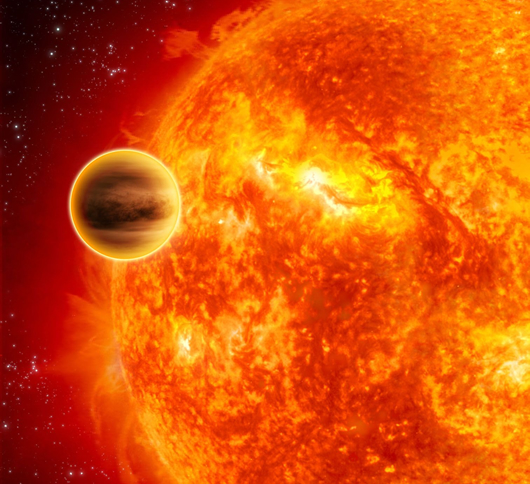Scots aid discovery of new planet
Astronomers at the University of St Andrews played a key role in the discovery of the biggest planet ever found, it was announced today (Thursday 13 August 2009).
The new planet – described as ‘bloated’ and ‘as dense as expanded polystyrene’ – has been found to orbit its star in the ‘wrong’ direction, using software developed by astronomers at the University of St Andrews.

The ‘huge new planet’, found orbiting a star 1000 light years away, was found by the UK’s WASP project, of which St Andrews is a founding member. The new planet, named WASP-17, was discovered by Dr David Anderson, of Keele University, and St Andrews’ graduate Amaury Triaud, now at Geneva Observatory.
WASP-17 is described by researchers as ‘the victim of a game of planetary billiards, flung into its unusual orbit by a close encounter with a ‘big brother’ planet’.
The first sign that WASP-17 was unusual was its large size. Though it is only half the mass of Jupiter it is bloated to nearly twice Jupiter’s size, making it the largest planet known.
Astronomers have long wondered why some extra-solar planets are far bigger than expected, and WASP-17 points to the explanation. Scattered into a highly elliptical, retrograde orbit, it would have been subjected to intense tides. Tidal compression and stretching would have heated the gas-giant planet to its current, hugely bloated extent.
Interestingly, the new planet was found to be orbiting the wrong way around its host star. Amaury and his colleague David Anderson, of Keele University, were surprised to find the planet in ‘retrograde’ orbit.
They said, “Since planets form out of the same swirling gas cloud that creates a star, they are expected to orbit in the same direction that the star spins. WASP-17 is the first planet to be found orbiting the wrong way. The likely explanation is that WASP-17 was involved in a near collision with another planet early in its history.”
“Newly formed solar systems can be violent places. Our own moon is thought to have been created when a Mars-sized planet collided with the recently formed Earth and threw up a cloud of debris that turned into the moon. A near collision during the early, violent stage of this planetary system could well have caused a gravitational slingshot, flinging WASP-17 into its backwards orbit.”
WASP-17 is the 17th new planet found by the “Wide Area Search for Planets” consortium of UK universities. The WASP team were able to detect the planet with an array of cameras that monitor hundreds of thousands of stars, searching for small dips in their light when a planet transits in front of them.
The University of St Andrews is a founding member of the WASP project. Amaury Triaud completed his MPhys degree in astronomy at the University of St Andrews, developing the software used in making this discovery as part of his final-year research project under the supervision of Professor Andrew Collier Cameron.
Professor Cameron commented on the latest discovery, “This bizarre planet provides us with evidence of violent processes that may be continuing to this day in the WASP-17 system. This planet and others we are finding make us appreciate how benign our own solar system is in comparison.”
ENDS
NOTE TO EDITORS:
PROFESSOR ANDREW COLLIER CAMERON (ST ANDREWS) IS AVAILABLE FOR INTERVIEW ON +44 1334 463147
NOTE TO PICTURE EDITORS:
THE FOLLOWING IMAGES ARE AVAILABLE AT:
Artist’s impression of two close extra-solar planets.
http://www.scitech.ac.uk/resources/image/Lonely1.jpg
Credit: KASI/CBNU/ARCSEC.
An artist’s impression of a transiting exoplanet.
http://photojournal.jpl.nasa.gov/catalog/PIA10364
Credit: ESA C Carreau
An artist’s impression of a transiting exoplanet.
http://www.scitech.ac.uk/PMC/PRel/images/ExoPlanet02.jpg
Credit: ESA C Carreau
An artist’s impression of a transiting exoplanet.
http://imgsrc.hubblesite.org/hu/db/2008/41/videos/a/stills/3/image.jpg
Credit NASA/Hubble
Issued by the Press Office, University of St Andrews
Contact Gayle Cook, Senior Press Officer on 01334 467227 / 462529, mobile 07900 050 103, or email [email protected]
Ref: New planet130809
View the latest University press releases at www.st-andrews.ac.uk
Category Research